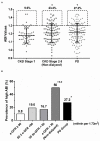Abnormal Calcium Metabolism Mediated Increased Risk of Cardiovascular Events Estimated by High Ankle-Brachial Index in Patients on Peritoneal Dialysis
- PMID: 35966542
- PMCID: PMC9369253
- DOI: 10.3389/fcvm.2022.920431
Abnormal Calcium Metabolism Mediated Increased Risk of Cardiovascular Events Estimated by High Ankle-Brachial Index in Patients on Peritoneal Dialysis
Abstract
Cardiovascular disease (CVD) is the leading cause of death in peritoneal dialysis (PD) patients. But the relationship between regular PD and the risk of major adverse cardiovascular events (MACE) remains controversial. The possible risk factors are not fully elucidated. This study aims to investigate the possible factors affecting the risk of MACE estimated by high ankle-brachial index (ABI) in PD patients. A total of 243 patients were enrolled and divided into chronic kidney diseases (CKD) stage 1, non-dialyzed CKD stages 2-5, and PD groups. The prevalence of high ABI, indicating increased MACE, was elevated with CKD progression but not further increased in PD patients. Systolic blood pressure was closely correlated with high ABI in non-dialyzed CKD patients (β = 0.059, P = 0.001). But in PD patients, serum calcium had a crucial effect on high ABI (β = -9.853, P < 0.001). Additionally, PD patients with high ABI tended to dialyze inadequately (Kt/V <1.7) compared to those with normal ABI (29.0 vs. 13.3%, P = 0.031). Further mediation analysis revealed that ~86.2% of the relationship between Kt/V and high ABI was mediated by serum calcium in PD patients (mediation effect = 86.2%, ab = -0.220, 95% CI: -0.381 to -0.059, P = 0.008), especially in those starting PD before 55 years of age and with normal body mass index. This present study indicated that improvement of PD adequacy by maintaining calcium balance might be a promising method to reduce the risk of MACE estimated by high ABI for PD patients.
Keywords: Kt/V; ankle-brachial index; calcium; peritoneal dialysis; vascular calcification.
Copyright © 2022 Su, He, Zhang, Zhang, Zhu, Chen and Huang.
Conflict of interest statement
The authors declare that the research was conducted in the absence of any commercial or financial relationships that could be construed as a potential conflict of interest.
Figures





Similar articles
-
Subclinical peripheral artery disease in patients undergoing peritoneal dialysis: risk factors and outcome.Perit Dial Int. 2009 Jan-Feb;29(1):64-71. Perit Dial Int. 2009. PMID: 19164255
-
Screening for Peripheral Vascular Disease: The Role of Ankle-Brachial Index (ABI) and Estimated Glomerular Filtration Rate (eGFR) Changes in Chronic Kidney Disease.Cureus. 2024 Oct 9;16(10):e71151. doi: 10.7759/cureus.71151. eCollection 2024 Oct. Cureus. 2024. PMID: 39525244 Free PMC article.
-
Atherosclerotic risk factors among ankle-brachial index and toe-brachial index in peritoneal dialysis patients.Ren Fail. 2007;29(7):835-41. doi: 10.1080/08860220701573541. Ren Fail. 2007. PMID: 17994452
-
Abnormal ankle-brachial index and risk of cardiovascular or all-cause mortality in patients with chronic kidney disease: a meta-analysis.J Nephrol. 2017 Aug;30(4):493-501. doi: 10.1007/s40620-017-0376-z. Epub 2017 Feb 15. J Nephrol. 2017. PMID: 28197971 Review.
-
Prognostic Value of Abnormal Ankle-Brachial Index in Patients With Coronary Artery Disease: A Meta-Analysis.Angiology. 2020 Jul;71(6):491-497. doi: 10.1177/0003319720911582. Epub 2020 Mar 13. Angiology. 2020. PMID: 32166959 Review.
Cited by
-
Association between dietary folate intake and severe abdominal aorta calcification in adults: A cross-sectional analysis of the national health and nutrition examination survey.Diab Vasc Dis Res. 2024 Mar-Apr;21(2):14791641241246555. doi: 10.1177/14791641241246555. Diab Vasc Dis Res. 2024. PMID: 38597693 Free PMC article.
References
LinkOut - more resources
Full Text Sources

